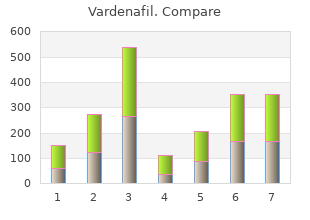

By: Brian M. Hodges, PharmD, BCPS, BCNSP

https://directory.hsc.wvu.edu/Profile/38443
Abdominal aortic aneurysm: Endovascular grafts oer a potential different to erectile dysfunction depression medication order vardenafil australia surgery hypogonadism erectile dysfunction and type 2 diabetes mellitus vardenafil 20mg fast delivery. Endovascular exclusion of descending thoracic aortic aneurysms and chronic dissections: Initial medical outcomes with the AneuRx system erectile dysfunction treatment san antonio buy vardenafil on line amex. Nonsurgical reconstruction of thoracic aortic dissection by stentgraft placement erectile dysfunction high blood pressure cheap vardenafil 20mg amex. Endovascular restore compared with open surgical restore of abdominal aortic aneurysm: Canadian practice and a scientific evaluation. A randomized trial evaluating conventional and endovascular restore of abdominal aortic aneurysms. Stentgraft restore versus open surgery for the descending aorta: A casecontrol study. Fenestration in endovascular grafts for aortic aneurysm forty seven of 57 restore: New horizons for preserving blood circulate in branch vessels. Endoluminal aortic grafting with renal and superior mesenteric artery incorporation by graft fenestration. Treatment of shortnecked infrarenal aortic aneurysms with fenestrated stentgrafts: Shortterm outcomes. Endovascular administration of juxtarenal aneurysms with fenestrated endovascular grafting. Interventional Procedure Consultation Document endovascular stentgraft placement in thoracic aortic aneurysms and dissections. Midterm survival and costs of treatment of sufferers with descending thoracic aortic aneurysms; endovascular vs. First experience in human beings with a permanently implantable intrasac pressure transducer for monitoring endovascular restore of abdominal aortic aneurysms. Direct intraaneurysm sac pressure measurement utilizing tippressure sensors: In vivo and in vitro evaluation. Durability and validity of a remote, miniaturized pressure sensor in an animal model of abdominal aortic aneurysm. Intraaneurysm pressure measurements in successfully excluded abdominal aortic aneurysm after endovascular restore. Is there a spot for exterior mesh wrapping of abdominal aortic aneurysms in the modern endovascular era Comparison of endovascular and open surgical repairs for abdominal aortic aneurysm. Longterm outcomes after endovascular abdominal aortic aneurysm restore: the primary decade. Systematic evaluation and metaanalysis of 12 years of endovascular abdominal aortic aneurysm restore. Fenestrated and branched stentgrafts for thoracoabdominal, pararenal and juxtarenal aortic aneurysm restore. Systematic evaluation and costeectiveness evaluation of elective endovascular restore compared to open surgical restore of abdominal aortic aneurysms. A meta evaluation of 21,178 sufferers present process open or endovascular restore of abdominal aortic aneurysm. Fenestrated endovascular grafts for the restore of juxtarenal aortic aneurysms: An evidencebased evaluation. Mortality after endovascular restore of ruptured abdominal aortic aneurysms: A systematic evaluation and metaanalysis. Endovascular restore of ruptured abdominal aortic aneurysm: A strategy in want of definitive evidence. Endovascular stents for abdominal aortic aneurysms: A systematic fifty two of 57 evaluation and economic model. Can laboratory exams predict the prognosis of sufferers after endovascular aneurysm restore Surgical administration of descending thoracic aortic illness: Open and endovascular approaches: A scientific assertion from the American Heart Association. In sufferers with ruptured abdominal aortic aneurysm does endovascular restore improve 30day mortality Endovascular restore of abdominal aortic aneurysms in low surgical danger sufferers: An evidence update. Present and way forward for branched stent grafts in thoracoabdominal aortic aneurysm restore: A singlecentre experience. Fenestrated and branched fifty three of 57 stent grafts for restore of complicated aortic aneurysms. Endovascular and open restore of abdominal aortic aneurysm are nonetheless both warranted a scientific evaluation. Comparison of longterm survival after open vs endovascular restore of intact abdominal aortic aneurysm among Medicare beneficiaries. Fenestrated endovascular restore for pararenal abdominal aortic aneurysms: A systematic 54 of 57 evaluation and metaanalysis. Totally percutaneous versus normal femoral artery entry for elective bifurcated abdominal endovascular aneurysm restore. Dutch experience with the fenestrated Anaconda endograft for shortneck infrarenal and juxtarenal abdominal aortic aneurysm restore. A propensity matched comparison of early outcomes for fenestrated endovascular aneurysm restore and open surgical restore of complicated abdominal aortic aneurysms. Riskadjusted metaanalysis of 30day mortality of endovascular versus open restore for ruptured abdominal aortic aneurysms. Fenestrated endovascular restore of abdominal aortic aneurysms is related to elevated morbidity but comparable mortality with infrarenal endovascular aneurysm restore. Endovascular restore versus open restore for inflammatory abdominal aortic aneurysms. The use of fenestrated and branched endovascular aneurysm restore for juxtarenal and thoracoabdominal aneurysms: A systematic evaluation and costeectiveness evaluation. Multibranched stentgrafts for the treatment of thoracoabdominal aortic aneurysms: A systematic evaluation and metaanalysis. Clinical Policy Bulletins are developed by Aetna to assist in administering plan benefits and represent neither oers of coverage nor medical advice. Participating suppliers are impartial contractors in private practice and are neither staff nor agents of Aetna or its aliates. Treating suppliers are solely liable for medical advice and treatment of members. A simplified section particularly addresses the individuals that fill in the medical certificates of reason for demise. This helps to cut back uncertainty for the classification or coding and to correctly monitor these deaths. Certifiers should embody as much detail as possible based on their data of the case, as from medical records, or about laboratory testing. If the decedent had existing chronic situations, similar to these, they need to be reported in Part 2 of the medical certificates of reason for demise. Yes No Unknown At time of demise Within forty two days before the demise Between forty three days as much as 1 yr before demise Unknown Did the being pregnant contribute to the demise Yes No Unknown Note: it is a typical course with a certificates is crammed in correctly. Please keep in mind to point out the style of demise and record in part 1 the exact kind of an incident or other exterior cause. Thus, whether or not a sequence is listed as �rejected� or �accepted� might mirror pursuits of importance for public health quite than what is acceptable from a purely medical viewpoint. Therefore, always apply these instructions, whether or not they can be thought-about medically appropriate or not. Frame A: Medical data: Part 1 and a couple of 1 Time interval from onset Cause of demise Report illness or situation to demise directly resulting in demise on line a a Acute respiratory misery syndrome J80 2 days Report chain of occasions in because of Due to: order (if applicable) b 10 days Pneumonia J18. Yes No Unknown Note: Code all entries in Part 1 and a couple of, and in this instance choose other viral diseases complicating being pregnant, childbirth and the puerperium (O98. Frame A: Medical data: Part 1 and a couple of 1 Time interval from Cause of demise Report illness or situation directly onset to demise resulting in demise on line a a Hypovolaemic shock T79.

Because of this diagnostic uncertainty erectile dysfunction treatment cialis order vardenafil 20mg fast delivery, some ocular tumor consultants recommend diagnostic biopsy icd 9 code for erectile dysfunction due to medication buy generic vardenafil 20 mg online, often by nice-needle aspiration erectile dysfunction diabetes type 2 treatment purchase vardenafil 20 mg with amex, for any small lesions on this category prior to erectile dysfunction tampa discount vardenafil express any treatment. Amelanotic melanocytic iris neoplasm in nevus versus melanoma category (iris nevoma). Note peaking of the pupil, restricted ectropion iridis, and intralesional blood vessels. Histopathologic examine of the excised tumor showed it to be a spindle A melanocytic tumor (ie, a nevus). Melanocytic subfoveal choroidal tumor in nevus versus 364 melanoma category (choroidal nevoma). It displays a outstanding ring of subretinal orange pigment (lipofuscin) on its surface and an related blister of overlying and surrounding exudative subretinal fluid. It was left untreated, spontaneously flattening slightly with disappearance of the orange pigment and subretinal fluid. Atypical Lymphoid Hyperplasia of the Uvea Atypical lymphoid hyperplasia of the uvea (previously termed benign reactive lymphoid hyperplasia) is focal or diffuse infiltration of the uvea by activated however benign-appearing lymphoid cells. Pathologically, the lymphoid cells are regularly organized into germinal centers that are evident on low to excessive energy microscopy. Immunohistochemically, the lymphoid cells comprising the infiltrates are often of B-cell lineage however regularly exhibit polyclonal features. Clinically, these lesions appear as tan to creamy focal to diffuse infiltrates in the iris or choroid. B-scan ultrasonography exhibits generalized choroidal thickening (typically with locally accentuated prominence) in diffuse instances, and ultrasound biomicroscopy confirms the solid delicate tissue character of iris and iridociliary infiltrates. The retina often stays connected or exhibits restricted shallow detachment over the choroidal infiltration, however progressive disruption of the retinal pigment epithelium develops in lots of instances. There could also be focal or diffuse pink anterior epibulbar lots harking back to main conjunctival lymphoma, or posterior peribulbar extraocular delicate tissue lots that may solely be evident on B-scan ultrasonography, computed tomography scanning, or magnetic resonance imaging. Biopsy, often transcleral incisional biopsy, is required to establish the diagnosis and rule out malignant uveal lymphoma. Treatment often consists of relatively low-dose fractionated exterior beam radiation remedy that often results in prompt and sustained medical regression. If imaginative and prescient is poor prior to treatment, it may not recuperate even if all of the uveal infiltrates completely regress. Occasional patients with atypical lymphoid hyperplasia of the uvea develop systemic lymphoma, so all affected patients ought to probably be monitored for systemic illness. Invasive medical and pathologic features are generally evident, and metastasis may happen. Primary Uveal Melanoma Primary uveal melanoma is an acquired malignant neoplasm that arises from uveal melanocytes. Uveal melanomas are uncommon in individuals under the age of 20 years however become progressively more frequent with advancing age. The common age at diagnosis is 40 to 45 years for iris melanoma and 55 to 60 years for choroidal and ciliary body melanoma. In the United States, the overall imply age-adjusted incidence is approximately 5 per million individuals per yr. In Europe a correlation has been identified between rising incidence and rising latitude, consistent with a protective impact of ocular pigmentation. Typically, iris melanoma is a darkish brown to tan nodular iris mass that replaces the traditional iris stroma (Figure 7�21). It regularly attracts outstanding intralesional blood vessels and routinely causes peaking and/or splinting of the pupil and ectropion iridis. Loss of cohesiveness of the tumor cells regularly results in satellite tv for pc tumors on the adjacent iris and in the angle on the trabecular meshwork, generally resulting in secondary glaucoma. Darkly melanotic iris melanoma, filling the anterior chamber angle inferonasally and approximately 3 mm thick. Typically ciliary body or ciliochoroidal melanoma is a darkish nodular peripheral fundus mass (Figure 7�22) related to outstanding localized dilation of blood vessels in the overlying sclera (sentinel blood vessels). The tumor typically extends into the peripheral iris, the place it may be evident on slitlamp biomicroscopy and gonioscopy. If thick sufficient, it may indent and even displace the crystalline lens and cause progressive astigmatism. The tumor occasionally invades the overlying sclera and extends to the exterior surface of the attention, the place it seems as a darkish brown flat to nodular vascularized episcleral mass. Darkly melanotic ciliary body melanoma, which has invaded the peripheral iris, with the primary portion of the melanoma lying posterior to the iris and indenting the lens. Typically choroidal melanoma is a darkish brown to pale golden subretinal mass (Figure 7�23) that, at detection, has a largest basal diameter of no less than 7 mm and/or thickness of more than 3 mm. The most distinctive form is a mushroom-like nodule with nodular apical eruption by way of Bruch�s membrane. B-scan ultrasonography is acceptable for determining the scale, form, and intraocular location of choroidal and ciliary body melanomas; identifying scleral invasion and transscleral extension to the orbit; and exhibiting (on dynamic imaging) vascular pulsations inside the tumor. It can also be useful for monitoring after eye-preserving treatment, corresponding to plaque radiotherapy (brachytherapy) and proton beam irradiation, for regression or relapse. Patients with main uveal melanoma are at risk of metastasis, especially to the liver, no matter how the primary intraocular tumor is managed. Prognostic components for metastasis and metastatic demise embody tumor dimension (larger dimension unfavorable), location (ciliary body least favorable, iris most favorable), melanocytic cell kind (epithelioid least favorable, spindle most favorable), vasculogenic mimicry pattern (complicated loops and networks unfavorable), and chromosome 3 standing (monosomy unfavorable, disomy favorable) and gene expression profile (Class 2 unfavorable, Class 1 favorable) of tumor cells. Several different treatment choices are available for main uveal melanomas of different sizes, intraocular areas, and related medical features. Iodine-one hundred twenty five (I-one hundred twenty five; United States) or ruthenium-106 (Europe) plaque radiotherapy and proton beam irradiation are probably the most generally employed remedies for small to relatively giant choroidal and ciliary body melanomas. All three forms of radiation remedy often induce tumor shrinkage, which is sustained long run, however are regularly related to delayed-onset radiation induced cataract, retinopathy, and optic neuropathy, and may possibly end in iris neovascularization, neovascular glaucoma, and profound or even complete visible loss. Transscleral tumor resection is employed in a couple of centers for selected ciliary body and choroidal melanomas, virtually all the time at the side of preoperative proton beam irradiation or postoperative plaque radiotherapy. Transvitreal endoresection of selected postequatorial choroidal melanomas is undertaken in a couple of centers, virtually all the time at the side of preoperative plaque or proton beam radiation remedy. No prospective comparative medical trials of surgical resection versus enucleation or plaque radiotherapy have been reported. Most iris and iridociliary melanomas are handled by surgical excision (iridectomy, iridocyclectomy) or plaque radiotherapy. Uveal Metastasis of Nonophthalmic Primary Cancer Nonophthalmic main cancers can metastasize hematogenously to the uvea. Clinically apparent uveal metastasis usually is off-white to pink to gold (most carcinomas) or to darkish brown (pores and skin melanomas). Iris metastasis usually is a progressively enlarging discohesive mass (Figure 7�24) which may be related to variable blurred imaginative and prescient, ocular ache, signs of intraocular irritation, and raised intraocular pressure. Although probably the most frequent situation is a solitary metastatic tumor in a single eye (eighty% of instances), about 20% of patients could have two or more discrete metastatic tumors in a single or each eyes. If left untreated, most uveal metastases enlarge measurably inside days to a couple of weeks. Multinodular metastasis to the iris and inferior anterior chamber angle from main lung cancer, causing distortion of the pupil. Unifocal homogeneously creamy coloured metastasis to the choroid from main breast cancer. The nonophthalmic main cancers that most commonly give rise to clinically detected uveal metastases are breast cancer in girls, lung cancer in males, and colon cancer in each groups. Uveal metastasis from nonophthalmic main cancer is the commonest malignant intraocular neoplasm. At post-mortem, approximately 90% of patients dying of metastatic illness have no less than microscopically evident metastatic cells inside ocular blood vessels and/or different intraocular tissues, however solely about 10% of such patients have uveal tumors that an ophthalmologist might be anticipated to 371 detect by medical examination. Many of these patients are likely to have developed their clinically detectable uveal metastatic illness through the last section of their sickness. Only about 50% expertise symptoms that prompt medical evaluation leading to detection of the uveal metastatic illness. Because the attention embryologically is an outgrowth of the brain, metastatic tumor to the attention should be thought to be metastasis to the brain. About 20% of patients with a metastatic tumor in a single or each eyes could have a concurrent intracranial metastasis detectable by computed tomography or magnetic resonance imaging scan. The median survival following detection of uveal metastasis is approximately 6 months, ranging from 12 months in breast cancer to 3 months in pores and skin melanoma.
Buy vardenafil 20mg visa. 7 Ways to Treat Erectile Dysfunction| Sex Problem Solution.

Syndromes
Raleigh Office:
5510 Six Forks Road
Suite 260
Raleigh, NC 27609
Phone
919.571.0883
Email
info@jrwassoc.com